A Final Project on “Communication of Safety in Factories” was submitted by Aaryaman Maheshwari (from Manipal University(MAHE), Manipal, Karnataka 576104 INDIA) to extrudesign.com.
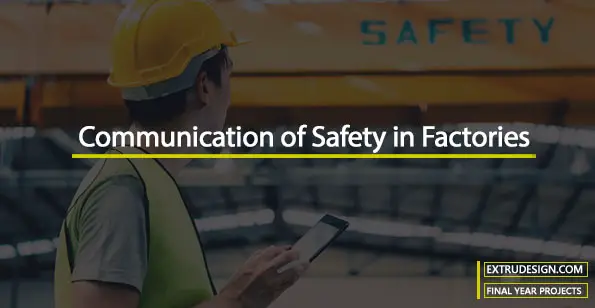
ABSTRACT
Factories are places of risky and dangerous work which involves heavy machinery, maybe chemicals, hardware etc. It definitely has a higher risk of causing injuries and damage to human lives employed. It is very essential that companies take care of their employees working in factories and make it a safe place to work. One of the primary reasons for clear, quality communication methods in work environments is the overall safety of employees.
To know about the communication of safety in factories, we decided to conduct a survey which consists of a questionnaire for different levels of employees in the organization regarding the safety and a safety meeting is conducted with the employees of Vizag Steel Plant to know about the safety in the organization. With this survey, we calculate the average score and use it for the result analysis.
With the survey conducted, we found out the average scores for the different organizations with which we can know the level of safety that is ensured and impart some safety norms and procedures to improve the communication of safety in the organization to avoid risks.
In the project, with the help of the survey and safety meeting, we found out the qualities required for an employee to maintain safety, the level of safety in the organizations and the importance of communication of safety in the factories.
1. INTRODUCTION
1.1 Introduction
Factories and Industries are spots of hazardous and risky work which includes overwhelming apparatus, perhaps synthetic compounds, and equipment and so on. It unquestionably has a higher danger of injuries and harm to human lives who are utilized in these manufacturing industries. It is extremely basic that organizations deal with their representatives working in plants and make it a sheltered and safe work environment. In this sense, communication really is a “need” inside the modern workforce. The main need of all businesses is the safety of their workers; a harmed representative is not really a beneficial or an efficient one. Since security starts things out, communication has immediately become a related top need. Without quality correspondence hardware, it tends to be almost difficult to carry on a reasonable discussion in a loud mechanical workplace. Without communication, profitability gets diminished by a noteworthy edge.
1.2 Introduction in Area of Work
A frequently neglected yet essential piece of any powerful working environment is communication. It ought to be ever-present in any workplace, regardless of whether it be an office or a construction site. Communication helps efficiency, safety and security and upbeat representatives, which are all significant if a business is to flourish. Safety and security is significant in any work environment, yet in certain conditions, it is a more conspicuous perspective than others. In a stockroom or building site, for instance, there is more noteworthy potential for a mishap than in any office. Guaranteeing that individuals speak with one another, regardless of whether that is when utilizing gear, driving vehicles or taking care of merchandise can extraordinarily diminish the danger of mishaps in the work environment. This goes for non-verbal correspondence, as well, for example, signage. For instance, fire exits must be unmistakably signposted, as must notice signs about wellbeing hardware and hazardous territories in a working environment.
1.3 Motivation to the Communication of Safety in Factories
The Visakhapatnam gas leak likewise alluded to as the Vizag gas leak, is a case of a modern mishap that happened at the LG Polymers synthetic plant on 7th May 2020. Specialists from the central government who were reviewing the plant said that it would have confronted a calamity had the infringement of safety standards at other storerooms at the plant gone unnoticed for a couple of more days. This could have been avoided entirely if the administering official would have ventured up and spoken about the current circumstance.
Situations like these can be limited and kept away from if appropriate safety preparation is given to every worker. This can be additionally done by recruiting a Safety Manager or the employees forming a safety group who communicate during regular intervals. Furthermore, regardless of whether in the far-fetched occasion of a mishap to happen, we would survey the compensation acts drawn out by the business and the administration.
1.4 Objective
Taking into account the above conversation, the need and worry for the well-being of an employee in this manner is a need of great importance. There are some immediate costs/impacts of a mishap however there are sure backhanded costs engaged with it additionally for example machine downtime, harm to machine, the ideal time of equipment and repulsiveness made among labourers, loss of time and so on in help cost pay, legitimate ramifications and associated costs and so on. So security measures would dispense with/maintain a strategic distance from the above expense yet would mean playing out their ethical duty towards labourers/administrators moreover.
A mishap is by the righteousness of a dangerous factor or aftereffects of a risky condition. It might likewise be the joined impact of two. A dangerous demonstration brings about the type of administrator/individuals doing things without proper authority, abuse of safety devices, overlooking alerts and insurances and so on.
1.5 Significance
Communication is significant for individual employees to gain from others, for socialization and coordination inside the organization, and for adjustment of the association to the evolving condition. Particularly in increasingly complex work conditions, it is vital to gain from practical experience. Be that as it may, as Carroll (1995:175) states: “In high-hazard industries, complexity, tight coupling, and invisibility make safe operation and learning from experience particularly difficult”.
1.6 Research
Various research scholars have contemplated the unique attributes and culture of small scale manufacturing units. While they go about a few different perspectives, their accentuation on occupational health and safety is by all accounts constrained. They do, in any case, give significant contributions to a more profound comprehension of the manner in which little scope ventures work.
The underlying cause of accidents is often of the two potential types,
- The Human error approach where the mistake is made by an individual due to a certain irrationality or a misunderstanding and
- The relationship between the working and organizational level of staff where there is a communication gap or unclear instructions.
2. LITERATURE REVIEW
2.1 Background Theory
In light of the work by Greenbaum (1974), Roberts and O’Reilly (1974/1) and Schuler and Blank (1976), we group communication in three types regulative and informative, informal and signage communication. The safety meetings can be portrayed as regulative and instructive communication. This correspondence arrangement endeavours to guarantee the adaptiveness of the association to shifted internal and external influences and is concerned with critical thinking, adjustment to change, system, new thought preparing, and reconciliation of sub-assignments. A few models are proposal frameworks, meetings to generate new ideas and participative critical thinking gatherings.
The casual correspondence during espresso or mid-day breaks can be named integrative correspondence. This correspondence arrangement is worried about affections for self, partners and work, and is straightforwardly identified with worker assurance it additionally includes flat correspondence between individuals from various offices and associations. In the event that fruitful, it mingles representatives so they relate to the association wherein they work, and adds to incorporating sub-undertakings. If not, clashes will thrive and these contentions cause a clumsy circumstance.
The signage correspondence is done by means of perception. All around set and intelligible admonition signs can constantly help the worker to remember the danger of the machinery and keep away from any terrible mishaps.
On the off chance that communication fails, individuals will in general allude to a ‘blame culture’. This blame culture emerges when there are obstacles in the chain of communication. Edmondson (1996) found that the willingness to discuss mistakes openly is a primary influence on detected error rates. The willingness is influenced by the shared perceptions of how consequential it is to make a mistake, and the perceived openness of the supervisor.
Diaz and Cabrera (1997) conducted a survey in three airport companies in Spain using an instrument designed from previous studies and obtained six factors on exploratory factor analysis (Company policies towards safety, Emphasis on productivity versus safety, Group attitudes towards safety, Specific strategies of prevention, Safety level perceived in the airport and Safety level perceived on the job). The reliability of the instrument was found high and the factors together explained 61 % of the total variance. Analysis revealed significant differences in the safety level in the companies.
Cohen (1975) and Smith (1975) inspected 42 coordinated sets of manufacturing industries. Those with lower mishap rates were described by: the nearness of safety officials with high position; the closeness of upper administrators who were in constant engagement with security exercises; preparing for new representatives, with visit retraining for existing workers; and increasingly unavoidable lines of casual communication between higher administration and labourers, for example, day by day communication among managers and their groups. Shannon (1996) led a postal survey of more than 400 assembling organizations, each having at least 50 workers. The characterizing highlights of associations with lower paces of lost time injury included: chiefs who saw more interest in dynamic by the workforce and progressively agreeable administration labourer religions; consolation of long haul profession duty; the arrangement of long and momentary handicap plans; definition of health and safety obligations in each director’s expected set of responsibilities; performance appraisals with topics related to health and safety; and increase attendance of ranking officers at health and safety gatherings.
2.2 Outcomes of Background Theory
Many authors conducted their studies by performing questionnaires on various industries. One such person was Cisco Van As who conducted a questionnaire on 8 chemical plants. In May 1999, this survey was sent to all employees within the production, maintenance and shipping sequences within organizations A-H, and their staff. The respondents were operators, different types of engineers, shippers, support staff, supervisors, etc. Four hundred and thirty-six employees cooperated in the research (56% response). The response can be qualified as relatively high, especially within safety research we can assume that respondents often hesitate because they are afraid to be blamed or punished. The measurement scales of the items are mostly five-point Likert scales (strongly agree … strongly disagree).
Table 1: Review of Questionnaire from organizations
| Organization | A | B | C | D | E | F | G | H | Total Population |
| Response % | 56 | 60 | 72 | 39 | 65 | 52 | 43 | 54 | 441 |
| Employee % | 74 | 88 | 90 | 96 | 84 | 68 | 78 | 86 | 366 |
| Supervisor % | 12 | 6 | 10 | 2 | 15 | 24 | 10 | 2 | 45 |
| Management Staff % | 14 | 6 | 0 | 2 | 1 | 8 | 12 | 12 | 30 |
These organizations are, a joint venture or a full daughter, part of multinational companies. To preserve confidentiality, these organizations will not be described in more detail.
Due to the ability of a questionnaire to gather information and make it possible to be interpreted in a statistical manner, we decided to take on this approach.
3. METHODOLOGY
3.1 Introduction
Many studies were conducted with the method of a questionnaire. A different questionnaire was planned out for each different type of industry. What we believe lacked in this questionnaire was that it was made for the employee and the employer as a whole. Hence, to obtain a more refined analysis we prepared two questionnaires that considered feedbacks from the employee as well as the employer. A questionnaire approach was chosen since it was statistically more reliable.
3.2 Questionnare
1. In which year did you get employed in your present business?
2. Has there been any injury in the workplace?
3. Indicate how you think in your industry does everyone prioritize these items between a scale of 1-5, 1 being the least and 5 being the highest priority.
Table 2: Employee Questionnaire about priority
| Item | Priority of Management | Priority of Supervision | Priority of Workmen |
| Quality | |||
| Cost and efficiency. | |||
| Production Volume | |||
| Safety |
4. According to you, to what extent can injuries be prevented?
- All can be prevented.
- Almost all can be prevented.
- Many can be prevented.
- Some can be prevented.
- Few can be prevented.
5. Does your industry have built-in safety measures and safety values such as documents, posts on bulletin boards, instructions on machinery, etc.
- Yes
- No
- I am not aware.
If Yes then,
- Are safety values up to date, well understood and have an important influence on safety?
- Are safety values are understood but neglected sometimes?
- Are safety values not understood and neglected most times?
6. To what extent did you receive your training in safety and occupational health during your job training when you joined this industry?
- Thorough and extensive training.
- Considerable training.
- Some training.
- Little Training.
- No Training.
7. Workplace hazards:
Table 3: Employee Questionnaire about Hazards
| How often do you… | Daily | Alternate days | Once a Week | Once a Month | Once a Year | DK/NA |
| Lift heavy objects. | ||||||
| Perform work tasks you are not familiar with. | ||||||
| Interact with Hazardous substances such as Chemicals and gases. | ||||||
| Work in high noise levels where you have to raise your voice to talk. | ||||||
| Stand for more than 2 hours in a row. | ||||||
| Listen to your Supervisor regarding safety instructions. |
8. Workplace Policies:
Table 4: Employee Questionnaire about policies
| At your workplace… | Strongly agree | Agree | DK/NA | Disagree | Strongly Disagree |
| Everyone receives the necessary safety equipment, training and safety guidelines. | |||||
| Regular communication of safety instructions between you and your supervisor. | |||||
| Active safety guidelines are present around machinery in an understandable language. |
9. Safety Awareness:
Table 5: Employee Questionnaire about safety awareness
| At your workplace… | Strongly Agree | Agree | DK/NA | Disagree | Strongly Disagree |
| You are clear about the regulations and your rights. | |||||
| You are aware of the terms of compensation in an event of an injury. | |||||
| You know the necessary precautions and the safety instructions in full length. | |||||
| You are clear about your employers’ rights and responsibilities in relation to workplace safety. |
10. Active Participation:
Table 6: Employee questionnaire about Active Participation
| At your Workplace… | Strongly Agree | Agree | DK/NA | Disagree | Strongly Disagree |
| You feel free to suggest and voice your opinion regarding work safety. | |||||
| Do you help identify hazards to the management? | |||||
| Communicate with your colleagues about safety risks. |
11. For the following questions please answer the range of 1-10 (1 being the lowest or strongly disagree and 10 being the highest or strongly agree):
- How accident prone is your workplace?
- Is there enough regulative and informative communication?
- Is there enough informal communication about safety?
- Is there enough signage communication?
- How likely are you to voice your concerns?
- Are you pressured to overlook certain safety irregularities?
- Do you think this is a safe working environment?
- Would you point out a work hazard to the management?
3.3 Questionnaire for Management Level Staff
1. Which year did the industry begin its operations?
2. What year did you get employed by your present business?
3. Which of the industrial sector best corresponds to your business?
- Construction
- Manufacturing
- Oil and Gas Exploration and Production
- Landscaping, Forestry or Fishing
- Transportation or Utilities
- Wholesale or Retail Trade
- Finance and Services
- Health
- Other
4. How many employees are currently employed at your business? (Mention DK if you do not know the answer)
5. Of the employees at this location, how many perform only managerial and administrative work?
- None
- 1% to 25%
- 26% to 50%
- 51% to 75%
- More than 75%
6. For the employees at your establishment who get the most safety training, how frequently is that training?
- Once a Month
- Once a Year
- More than Once a Year
- Less than Once a Year
- On the job as needed
- None
7. Does a safety committee exist?
- Yes
- No
- Don’t know
If Yes then how often are safety meetings held?
- Every week or every two weeks.
- Every month.
- Every alternate month.
- Less frequently than once in 6 months.
- Not regular at all.
8. Does the safety committee consist of employees working at ground level?
- Yes
- No
9. Indicate how you think in your industry does everyone prioritize these items between a scale of 1-5, 1 being the least and 5 being the highest priority.
Table 7: Management Questionnaire about priority
| Item | Priority of Management | Priority of Supervision | Priority of Workmen |
| 1. Quality | |||
| Cost and efficiency. | |||
| Production Volume | |||
| Safety |
10. How often do you participate in safety activities such as meetings, committees or helping others with safety guidelines?
- Regularly
- Often
- Sometimes
- Not Much
- Not at all
11. To what extent did you receive your training in safety and occupational health during your job training when you joined this industry?
- Thorough and extensive training.
- Considerable training.
- Some training.
- Little Training.
- No Training.
12. To what extent are injuries, safety incidents and the like investigated, reported and action is taken?
- All injuries are thoroughly investigated with immediate action.
- Most injuries are investigated with most recommendation implemented.
- Many are investigated with only most of some recommendations are implemented.
- Only the most serious of injuries are investigated.
- Injuries and incidents are not usually investigated.
13. Workplace Policies:
Table 8: Management questionnaire about policies
| At your workplace… | Strongly agree | Agree | DK/NA | Disagree | Strongly Disagree |
| Everyone receives the necessary safety equipment, training and safety guidelines. | |||||
| Regular communication of safety instructions between you and your supervisor. | |||||
| Active safety guidelines are present around machinery in an understandable language. | |||||
| They inform you about the Workmen Compensation Act in India in a way that you understand. | |||||
| The safety committee investigates workplace injuries immediately. |
14. For the following questions please answer the range of 1-10 (1 being the lowest or strongly disagree and 10 being the highest or strongly agree):
I. How accident-prone is your workplace?
II. Is there enough regulative and informative communication?
III. Is there enough informal communication about safety?
IV. Is there enough signage communication?
V. How likely are you to voice your concerns?
VI. Are you pressured to overlook certain safety irregularities?
VII. Do you think this is a safe working environment?
VIII. Would you point out a work hazard to the management?
4. RESULT ANALYSIS
The estimation of results was finished by scoring the reactions we got from our questionnaire. Consider Tables 3.1 and 3.6. Every reaction was given a score from 1 to 5 and in the event that a labourer was documenting the survey, at that point just his priority score was considered. For instance; if a management level staff say Officer A was providing his responses then just his priority score was considered.
Officer A Response:
Table 9: Officer Response for Priority
| Item | Priority of Management | Priority of Supervision | Priority of Workmen |
| 1. Quality | 4 | 3 | 2 |
| Cost and efficiency. | 4 | 3 | 1 |
| Production Volume | 3 | 4 | 3 |
| Safety | 3 | 3 | 4 |
Besides, Questions 11 and 14 from Questionnaire for Employee and Management level staff separately are likewise considered for scoring. These decide the sum and nature of communication that occurs in the work environment. The scoring for these was done from 1 to 10. For instance:
I. How accident-prone is your workplace? 4
II. Is there enough regulative and informative communication? 6
III. Is there enough informal communication about safety? 8
IV. Is there enough signage communication? 9
V. How likely are you to voice your concerns? 7
VI. Are you pressured to overlook certain safety irregularities? 2
VII. Do you think this is a safe working environment? 6
VIII. Would you point out a work hazard to the management? 9
From the above questions, inquires 2, 3, 4, 5, 7 and 8 mean a positive score while questions 1 and 6 are negative scores. After this, all the scores are combined and the outcome for every individual is determined. A higher score approaches a superior and more secure workplace with a lot of indispensable and vital communication.
Three organizations participated in the above questionnaire. The three businesses are (i) Mitshuoshi Corporation, (ii) Travelaids India and (iii) Organization X (they participated unofficially and would not like to divulge their name as per their wish).
Mitshuoshi Corporation has a business in Specialized Construction and Services in HVAC (Heating, Ventilation and Air Conditioning). They have a permanent staff of 26 employees and have contracted labour of 140. They are situated in Kolkata. They have multiple business locations such as in Siliguri, Odisha, Goa, Jharkhand and Florida.
Travelaids India has a business in the manufacture of Corrugated Boxes. They have a permanent staff of 20 and contracted labour of 100. They are a Kolkata based company.
Organization X is an industry that produces Pistons. They are based in the city of Kolhapur.
They have an administrative staff of 56 and skilled labour of 476.
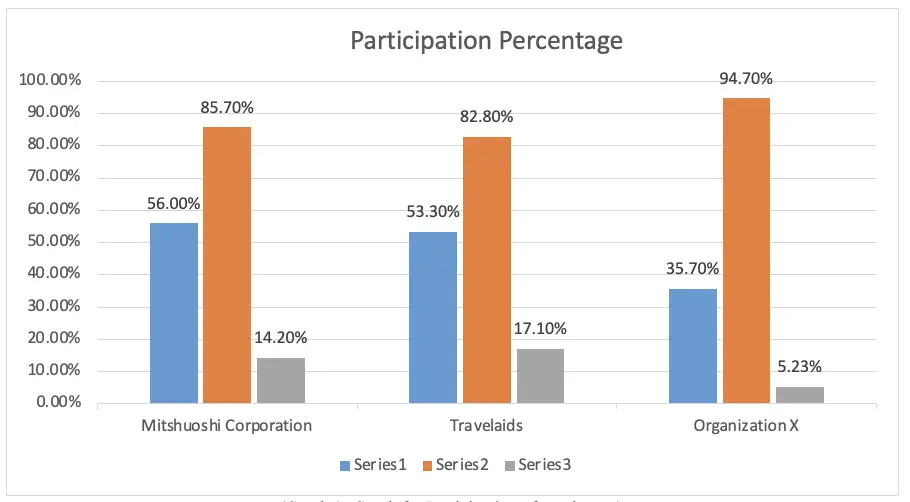
In the above data interpretation, Series 1 is the percentage of participation of employees over the total number of employees.
Series 2 is the percentage of participation of Labor/Ground level workmen over the total number of individuals that participated.
Series 3 is the percentage of participation of Supervision and Management Level staff together over the number of individuals who participated.
A score of every individual was averaged out with respect to the number of employees and tabulated in the table given below:
Table 10: Average scores of the organizations
| Mitshuoshi | Travelaids | Organization X | |
| Accident Prone(Minor Accidents) | (2,1) | (1,1) | (3,1) |
| Regulative & Informative Communication | (7,8) | (6,7) | (8,9) |
| Informal Communication | (9,7) | (8,8) | (7,8) |
| Signage Communication | (7,8) | (6,5) | (10,9) |
| Ability to voice concerns | (9,8) | (8,8) | (8,9) |
| Pressured to overlook | (1,2) | (2,2) | (1,2) |
| Ability to point out work hazards if any | (8,7) | (7,9) | (9,10) |
| Overall Safe Environment | (9,10) | (9,9) | (8,9) |
Here the scores are (Average score of Labor, Average score of Management Staff).
Therefore the overall scores we calculated from our findings out of (80, 80) were as follows:
1. Mitshuoshi received a score of (61, 58).
2. Travelaids India received a score of (57, 61).
3. Organization X received a score of (63, 64).
This is how we were able to determine the extent of safety measures existing in each company.
In regard to the project “Communication of Safety in Factories”, a meeting was also attended amongst a small group of employees from Vizag Steel Plant to discuss the safety methods adopted in the organization. In the meeting, it was found out that Vizag Steel Plant takes the safety of its employees very seriously and the best efforts are put in to ensure that the employees stay safe. During the discussion, the procedures for the safety of the employees were found out as follows:
- Publication of responsibility and duties of the person involved in the safety management system.
- Registration and control of safety standards including a register of significant incidents
- To establish regular audits and revisions to ensure that the corrective actions are executed.
- Early detection of deviations and/or procedures that can deteriorate or degrade the safety levels.
- Personnel involved in the system to report the detected risks to the appropriate level of the organization.
Safety at VSP is the responsibility of the Safety Engineering Department (SED). SED imparts regular safety training as well as refresher safety training to its employees, conducts safety inspections, and conducts campaigns to spread awareness of safety amongst the employees. The possible hazards at VSP were found out to be fire hazards, toxic hazards, explosion hazards, cold burns, and accidents due to materials. To avoid these the employees are given strict instructions to wear the appropriate suit according to the environment and to handle the machines accordingly. In case of any accident, VSP follows an emergency action plan which begins with the assessment of the principal hazards like fire, chemicals etc. With growing complexity, more systematic and deep risk identification investigation is done.
With the help of the Questionnaire and the insight from the safety meeting, we were able to chart out the qualities required by an employee to remain responsible and take necessary actions when required. Experience has shown that certain personal and organizational traits are present in positive safety culture. These traits can be listed below in the following chart.
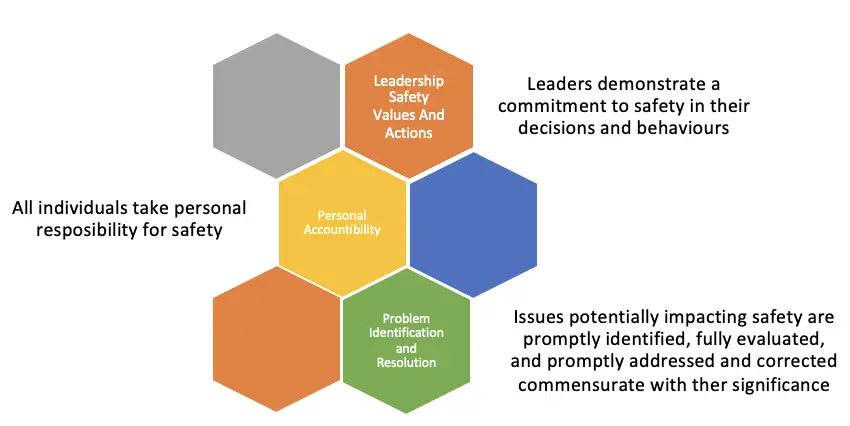
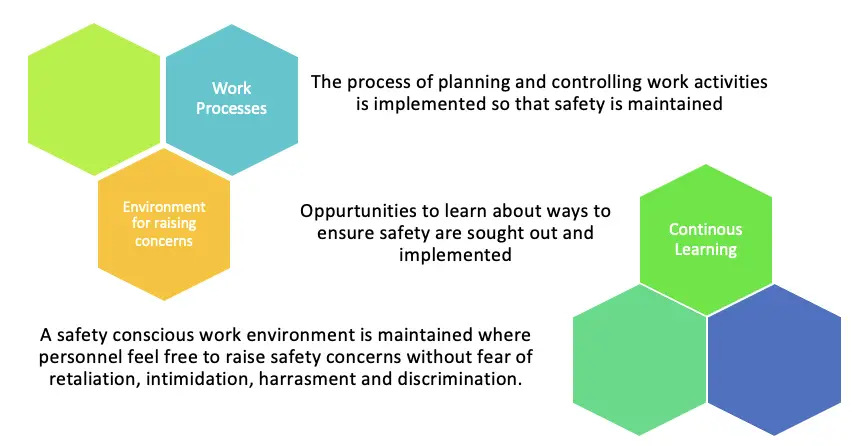
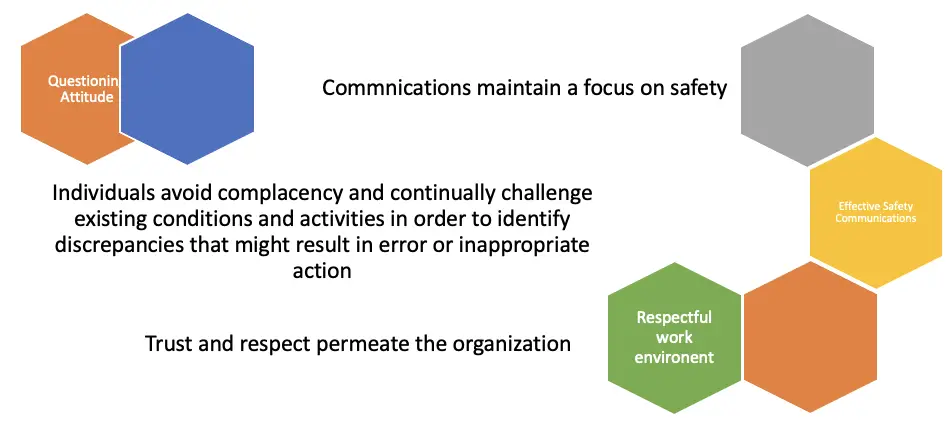
5. CONCLUSION
Despite the fact that safety measures are rehearsed by each industry, these measures can in any case be refreshed and refined habitually. From our collection of information and research through past paper we found that communication in the levels of leadership consistently diminished as we went upwards in the chain. This implied informal communication between a business and a worker can in any case be improved. Besides, we found that Signage communication was not in every case very much positioned and not generally visually clear to the eye. Some of the warning signs were outdated. This must be improved as when labourers work without management they can clear questions in regards to their safety quickly. The basic work should likewise be urged to voice his assessments and not be compelled to keep quiet. Correspondence is consistently the key since it maintains a strategic distance from the “Blame culture” completely.
Safety can further be improved by using innovative production/ working methods to reduce injuries at the workplace. Being liberal and just as far as compensation costs go. Increasing productivity without creating mental/ physical stress to the employees. Offering good working conditions in order to ensure employee retention. In industries to avoid injuries factors such as strong management commitment to safety as reflected by management’s knowledge of the problems, their convictions that high safety standards were attainable and their demonstrated work toward those ends were present.
After our in-depth study, we realized that many scholars did a theoretical study and very little acquiring of data. This made us reach two significant points for future research.
First, it is important to enlarge the coverage of the research. (i) Use of preexisting research to enlarge it on a geographical scale. (ii) To extend the research to bigger industries and enterprises. (iii) Valuation of the impact of preventive activities.
Secondly, it is necessary to develop more inclusive research, in order to learn the whole intervention system- ranging from the government to owners and managers of the small scale firms.
One of the pioneering steps taken by the Indian government to ensure the safety of labourers was to implement a web-based labour inspection scheme. Under the scheme, there exist 1,800 labour safety inspectors. Instead of conducting sudden factory visits, a fully computerized system will randomly guide the inspector and shall allot the inspecting staff to particular companies.
REFERENCES
- Carrol, J.S 1995: Incident Review in High-Hazard Industries: Sense Making and Learning Under Ambiguity and Accountability, in Industrial and Environmental Crisis Quarterly (Vol.9, #2, p.175-97)
- Greenbaum, H.H 1974: Controlling the Controllable: the Management of Safety (Leiden, ISBN 90-6695-106-0)
- Roberts, K.H and C.A. O’Reilly 1974-1: Failures in Upward Communication in Organizations (Vol.17, #2, June, p.205-15)
- Roberts, K.H and C.A. O’Reilly 1974-2: Measuring Organizational Communication, in Journal of Applied Psychology (Vol.59, #3, p.321-6)
- Schuler, R.S. 1979: Relationships among Types of Communication, Organizational Level, and Employee Satisfaction and Performance, in: IEEE Transactions and Engineering Management (August, Vol.EM-23, #3, p.124-9)
- Edmondson, A.C. 1996: Learning from Mistakes is Easier Said than Done. Journal of Applied Behavioral Science (Vol.32, #1, March, p.5-28)
- Van As, S. 2001: The Measurement of Accident Proneness. (SOM Research Report)
- Cohen and Smith 1975: Authority Structure and Industrial Accidents. (Vol.34, #1, p.43-71)
- Diaz and Carbera 1997: Injury and ill-health in Manufacturing Industry, Industrial Crisis Quarterly (Vol.5, #1, p.59-75)
Credits: This project work”Communication of Safety in Factories” is completed by M. Prudhvi Himavanth and Aaryaman H. Maheshwari under the guidance of Assistant Professors Augustine B. V. Barboza (Department of Mechanical and Manufacturing Engineering), and Abhay Shetty (Department of Humanities and Management) from Manipal University(MAHE), Manipal, Karnataka 576104 INDIA.

Leave a Reply